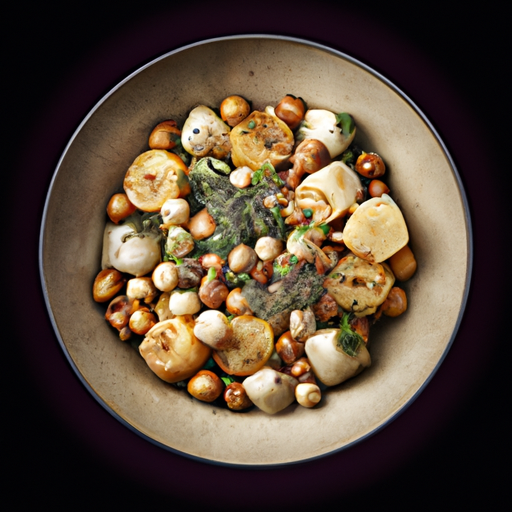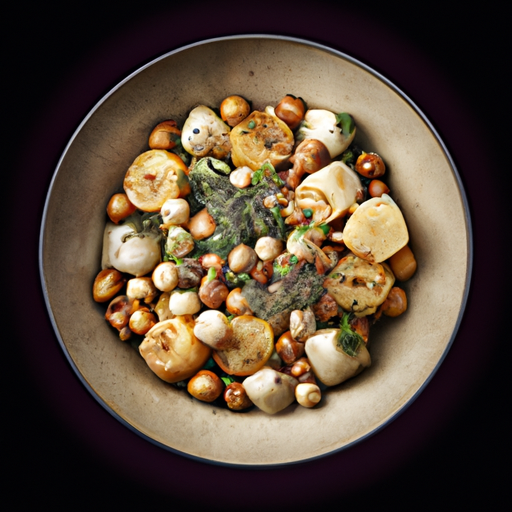Restaurant Industry Trends 2023
Whether you’re a food lover or a restaurant owner, staying up to date with the latest trends in the industry is essential. In this article, we will explore the top restaurant industry trends to anticipate in 2023. From the rise of plant-based options to the integration of technology, these trends are shaping the future of dining experiences. So grab a seat and get ready to discover the exciting shifts happening in the restaurant scene.

Table of Contents
Sustainability and Eco-Friendly Practices
Plant-based menus
As sustainability and environmental consciousness continue to gain traction, more and more restaurants are offering plant-based menus to cater to the growing demand for vegetarian and vegan options. By shifting the focus from animal-based dishes to plant-based alternatives, these establishments are not only reducing their carbon footprint but also providing healthier options for their customers. The adoption of plant-based menus not only appeals to those who follow a plant-based lifestyle, but also to individuals who are interested in exploring new flavors and embracing a more sustainable way of eating.
Reducing food waste
Food waste is a significant issue in the restaurant industry, and many establishments are taking steps to minimize it. From implementing proper inventory management systems to creative initiatives such as “ugly produce” utilization, restaurants are finding innovative ways to reduce food waste. Some restaurants even collaborate with local food banks or nonprofits to donate surplus food, ensuring that it doesn’t go to waste. By actively addressing the issue of food waste, restaurants not only contribute to a more sustainable food system but also demonstrate their commitment to social responsibility.
Sustainable packaging
With the increasing demand for food delivery and takeout, there’s a growing need for sustainable packaging solutions. Restaurants are now seeking eco-friendly alternatives to traditional plastic packaging, such as biodegradable or compostable options. By opting for sustainable packaging, establishments can significantly reduce the environmental impact of their operations. Additionally, some restaurants are implementing initiatives to encourage customers to bring their own containers for leftovers or offering discounts to those who opt for reusable packaging. These practices contribute to a more sustainable dining experience and reflect the values of environmentally conscious consumers.
Technology Advancements
Mobile ordering and payment
The rise of mobile technology has revolutionized the restaurant industry, providing customers with the convenience of ordering and paying for their meals using their smartphones. Mobile ordering and payment apps allow for a seamless dining experience, eliminating the need to wait in long queues or handle physical menus and credit cards. By adopting mobile ordering and payment systems, restaurants can enhance operational efficiency, reduce wait times, and provide a more convenient experience for their customers.
Tableside ordering and payment
Tableside ordering and payment systems are another technological advancement that is becoming increasingly popular in the restaurant industry. With these systems, customers can place their orders directly from tablets or devices provided at the table, eliminating the need for waitstaff to take orders manually. Additionally, these systems often include payment functionalities, allowing customers to settle their bills right at the table. This not only streamlines the ordering process but also enhances the overall dining experience by reducing wait times and increasing customer control.
Kitchen automation
To improve efficiency and streamline operations, many restaurants are embracing kitchen automation technologies. Automated systems can handle tasks such as food preparation, cooking, and even plating, reducing the need for excessive manual labor. By implementing kitchen automation solutions, restaurants can enhance consistency, minimize errors, and optimize workflow, ultimately leading to increased productivity and improved customer satisfaction. These technological advancements free up staff members to focus on other aspects of the dining experience, such as customer service and food quality.
Health and Wellness Focus
Increased demand for healthy options
Health and wellness have become significant priorities for many individuals, and this trend has translated into the restaurant industry. Customers are increasingly seeking out establishments that offer healthy menu options, including dishes that are low in calories, fat, and sodium. Restaurants are responding to these demands by incorporating nutritious ingredients and preparation methods that prioritize health without compromising on taste. By providing healthier options, restaurants can attract health-conscious individuals while simultaneously catering to a broader customer base.
Vegetarian and vegan options
The popularity of vegetarian and vegan diets has seen a significant surge in recent years, leading to a greater demand for plant-based options on restaurant menus. Many establishments are now going beyond the traditional salad or vegetable stir-fry and offering innovative and flavorful vegetarian and vegan dishes. By accommodating these dietary preferences, restaurants ensure that they are inclusive and able to cater to a wide range of customers. Moreover, this shift toward vegetarian and vegan options aligns with sustainability goals, as plant-based diets have a lower impact on the environment compared to animal-based diets.
Allergen-free offerings
As food allergies and intolerances become more prevalent, restaurants are adapting to cater to these dietary restrictions. Many establishments now have dedicated menus or sections on their menus that highlight allergen-free options. Additionally, staff members are trained to handle and prevent cross-contamination, ensuring the safety of customers with specific dietary requirements. By offering allergen-free options, restaurants provide a dining experience that is inclusive and accommodating to individuals with food sensitivities, allergies, or intolerances.

Virtual and Ghost Kitchens
Rise of delivery-only restaurants
The surge in food delivery services has given rise to a new type of restaurant: the delivery-only or virtual kitchen. These establishments focus solely on preparing food for delivery and do not have a physical dine-in presence. By eliminating the need for a traditional brick-and-mortar location, virtual kitchens can significantly reduce overhead costs and operational complexities. This model allows for increased efficiency in fulfilling delivery orders and caters to the growing demand for convenient dining options. Virtual kitchens often operate through partnerships with third-party delivery platforms, leveraging their existing infrastructure to reach a broader customer base.
Shared commercial kitchen spaces
Shared commercial kitchen spaces, also known as ghost kitchens or kitchen incubators, provide a cost-effective solution for aspiring restaurant owners and food entrepreneurs. These shared spaces offer fully equipped professional kitchens that can be rented on an as-needed basis. By sharing resources and infrastructure, individuals and small businesses can minimize initial investment costs and focus on food preparation and delivery without the burden of managing a full-scale restaurant. Shared commercial kitchen spaces have facilitated the growth of food delivery services by providing a supportive environment for culinary innovation and entrepreneurship.
Lower overhead costs
Operating a traditional restaurant comes with significant overhead costs, including rent, utilities, and staffing. However, virtual kitchens and shared commercial kitchen spaces offer a solution to minimize these expenses. By eliminating the need for a physical storefront, restaurants can redirect their financial resources towards improving food quality and customer experience. This reduced cost structure allows for greater flexibility, enabling restaurants to adapt quickly to changing market demands and invest in sustainable practices, such as eco-friendly packaging or higher-quality ingredients. The lower overhead costs associated with virtual and ghost kitchens contribute to the financial viability and long-term success of these establishments.
Personalized Dining Experiences
Customizable menus
To cater to individual preferences and dietary restrictions, many restaurants are adopting customizable menu options. These menus allow customers to select ingredients, cooking styles, or portion sizes according to their specific preferences, creating a personalized dining experience. Customizable menus empower customers to have more control over their meals and enable restaurants to accommodate a broader range of dietary needs and preferences. Embracing customization not only enhances customer satisfaction but also fosters creativity and innovation in the culinary industry.
Enhanced customer preferences tracking
Restaurants are utilizing technology to track and analyze customer preferences in order to provide a more personalized dining experience. By leveraging data from loyalty programs, online reviews, or feedback surveys, establishments can gain valuable insights into customer preferences. This information can then be used to tailor menus, promotions, and even restaurant ambiance to meet specific customer needs. Tracking customer preferences allows for targeted marketing efforts and ensures that restaurants are consistently meeting and exceeding customer expectations.
Specialty chef-driven experiences
To provide unique and memorable dining experiences, some restaurants are embracing specialty chef-driven concepts. These experiences may include chef’s table dining, where customers are seated at a table within the kitchen itself, allowing them to witness the culinary magic firsthand. Other chef-driven experiences may involve exclusive tasting menus or themed pop-up events. By showcasing the creativity and skills of talented chefs, these specialty experiences elevate the dining experience and create a sense of anticipation and excitement among customers.
Convenience and On-Demand Services
Food delivery apps
Food delivery apps have transformed the way people order and enjoy their meals. These platforms allow customers to explore various restaurant options, browse menus, and place orders for delivery or pickup with just a few taps on their smartphones. By partnering with third-party delivery services or developing their own delivery capabilities, restaurants can tap into a wider customer base and meet the growing demand for convenient and on-demand dining experiences. Food delivery apps offer convenience, choice, and flexibility for both customers and establishments.
Curbside pickup
curbside pickup has gained popularity as a convenient alternative to traditional dine-in or delivery options. Restaurants can provide designated curbside pickup zones or parking spaces where customers can collect their orders without leaving their vehicles. This service allows customers to enjoy restaurant-quality meals from the comfort of their cars, saving them time and effort. By offering curbside pickup, restaurants not only meet the needs of busy customers but also provide a safe and contactless option during times when health and safety are of utmost importance.
24/7 operations
To cater to the increasing demand for around-the-clock dining options, some establishments are embracing 24/7 operations. These restaurants are open for extended hours, allowing customers to satisfy their cravings or enjoy a meal at any time of the day or night. The availability of 24/7 dining options caters to various schedules and lifestyles, accommodating individuals who work night shifts, travelers in need of a late-night meal, or those who simply prefer unconventional dining times. By operating continuously, restaurants can maximize their revenue potential and attract a diverse customer base.
Culinary Cross-Pollination
Fusion cuisine
Fusion cuisine combines elements from different culinary traditions to create innovative and unique flavor profiles. Restaurants are increasingly embracing fusion cuisine, which blends ingredients, techniques, and flavors from diverse cultures and cuisines. This culinary cross-pollination allows chefs to experiment, challenge traditional norms, and create exciting dining experiences that reflect the global influences of modern society. By incorporating fusion cuisine into their menus, restaurants demonstrate their commitment to culinary innovation and provide customers with a delightful fusion of flavors and textures.
Ethnic food influence on mainstream menus
The popularity of ethnic cuisines and flavors has significantly influenced mainstream menus. Restaurants are incorporating dishes and ingredients from various regions around the world, allowing customers to indulge in diverse culinary experiences. From Mexican-inspired street food to Indian-inspired curries, ethnic food influences are pervasive in modern menus. By embracing the rich diversity of global flavors, restaurants can attract a broader customer base and provide an inclusive dining environment that celebrates different cultures and their culinary traditions.
Global flavor exploration
Restaurants are taking patrons on culinary journeys by exploring global flavors and ingredients. From unique spice blends to exotic fruits and vegetables, the diverse range of global flavors offers a wealth of opportunities for chefs and restaurateurs. By sourcing and incorporating ingredients from different regions, establishments can create menus that transport customers to far-off destinations and offer unforgettable dining experiences. Global flavor exploration encourages curiosity, openness, and appreciation for the rich cultural tapestry of the global dining landscape.
Inclusivity and Diversity
Workforce diversity
Restaurants are increasingly recognizing the importance of a diverse workforce. By actively promoting diversity and inclusivity in their hiring practices, establishments can create a welcoming and inclusive environment for both employees and customers. Diversity within a staff, which includes individuals from different cultural backgrounds, age groups, and abilities, fosters creativity, innovation, and a broader range of perspectives. By embracing workforce diversity, restaurants can cultivate an inclusive culture that reflects the values of the communities they serve.
Celebration of diverse cuisines
Restaurants are becoming ambassadors of diverse cuisines, celebrating the flavors and culinary traditions of different cultures. Establishments are showcasing dishes from various regions around the world, introducing customers to new ingredients, cooking techniques, and flavors. By embracing diverse cuisines, restaurants contribute to cultural exchange, stimulate curiosity, and foster a deeper appreciation for different backgrounds and traditions. Celebrating diverse cuisines not only enriches the dining experience but also promotes inclusivity and cultural understanding.
Catering to dietary restrictions and preferences
Restaurants are proactively catering to a wide range of dietary restrictions and preferences to ensure that everyone can enjoy a satisfying dining experience. From gluten-free and dairy-free options to accommodating specific allergies or religious dietary requirements, restaurants are going above and beyond to meet the diverse needs of their customers. Staff members are trained to be knowledgeable about ingredients and potential allergens, allowing them to provide accurate information and offer suitable alternatives. By catering to dietary restrictions and preferences, restaurants demonstrate their commitment to inclusivity and customer satisfaction.
Social Media Marketing
Influencer collaborations
Restaurants are leveraging social media influencers to showcase their culinary offerings, ambiance, and unique experiences. By partnering with influencers who align with their brand and target audience, establishments can reach a wider customer base and generate buzz around their offerings. Influencers create visually appealing content, including photos and videos, which can help restaurants attract new customers and increase brand visibility. By collaborating with influencers, restaurants can tap into the power of social media marketing and effectively showcase their brand to potential customers.
User-generated content
User-generated content has become a valuable marketing tool for restaurants. Customers often share their dining experiences on social media platforms, posting photos, reviews, and recommendations. Restaurants can capitalize on this trend by encouraging customers to share their experiences and engage with their social media accounts. By reposting or featuring user-generated content, establishments not only boost customer engagement but also create a sense of authenticity and credibility around their brand. User-generated content serves as a powerful form of social proof and can significantly impact a restaurant’s online presence.
Virtual food tours
Virtual food tours have gained popularity as a way for customers to experience the culinary offerings of various establishments from the comfort of their homes. Restaurants can partner with virtual food tour platforms to showcase their menus, signature dishes, and unique dining experiences through immersive digital experiences. These virtual tours allow prospective customers to get a taste of what a restaurant has to offer before making a reservation or placing an order. By participating in virtual food tours, restaurants can reach a wider audience and pique the curiosity of potential customers, ultimately driving foot traffic and online orders.
Delivery and Takeout Dominance
Upsurge in third-party delivery services
The demand for convenient food delivery has led to a proliferation of third-party delivery services. These platforms partner with restaurants to offer delivery services, handling logistics and connecting establishments with a large customer base. By collaborating with third-party delivery services, restaurants can tap into the growing market of consumers who prefer to enjoy restaurant-quality meals from the comfort of their own homes. Delivery services provide a convenient avenue for restaurants to expand their reach, increase revenue, and cater to the evolving preferences of customers.
In-house delivery fleets
Some restaurants are opting to establish their own in-house delivery fleets to maintain control over the delivery process and further streamline operations. By owning and managing their delivery operations, establishments can ensure delivery times, maintain quality standards, and enhance customer satisfaction. In-house delivery fleets can also provide opportunities for branding and marketing initiatives, as restaurants can feature their branding on delivery vehicles and packaging. While establishing an in-house delivery fleet requires additional investment and resources, it allows for greater control and customization of the delivery experience.
Optimizing takeout packaging
As takeout and food delivery become increasingly dominant in the restaurant industry, establishments are focusing on optimizing their takeout packaging. Restaurants are exploring eco-friendly alternatives to traditional plastic containers, opting for compostable or biodegradable materials. Additionally, packaging design has become an important consideration, as it plays a significant role in ensuring that food stays fresh and presentable during transit. By investing in high-quality takeout packaging, restaurants can provide a positive customer experience and mitigate potential issues related to food quality or presentation.






